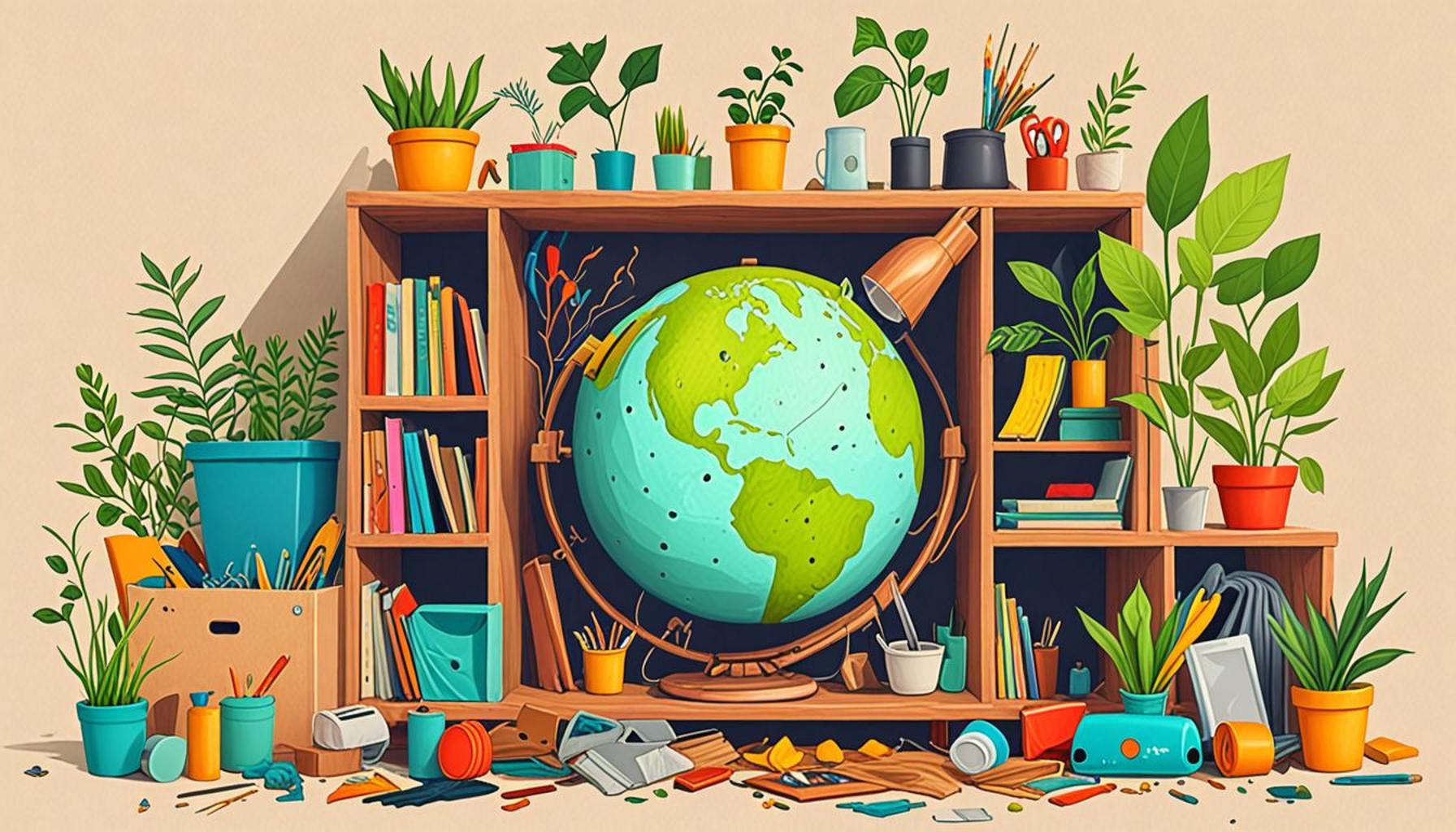Decluttering and Sustainability: Techniques to Reduce Waste and Create an Eco-Friendly Home

Embracing the Power of Decluttering
In an era where environmental consciousness is on the rise, decluttering emerges as a powerful tool for sustainability. It’s not merely about reducing clutter; it’s about making intentional choices that promote a healthier planet. By embracing simple techniques, individuals can significantly reduce waste while fostering an eco-friendly home. As people become more aware of their environmental footprints, the concept of decluttering serves as a practical approach to minimizing one’s impact while enhancing personal well-being.
Consider the myriad benefits of decluttering:
- Enhances living space quality: An organized environment can lead to improved focus and productivity. For instance, studies suggest that chaotic spaces can distract from work or relaxation, while a tidy room helps create a more tranquil atmosphere.
- Encourages mindful consumption: By thoughtfully evaluating what we bring into our homes, we begin to understand the value of items rather than mindlessly accumulating possessions.
- Reduces overall stress and anxiety: A clutter-free space can create peace of mind, allowing individuals to breathe easier and feel more in control of their surroundings.
But how can one effectively declutter and contribute to sustainability? Here are some strategic techniques:
- Donation and Recycling: Items you no longer need—clothes, electronics, furniture—can be donated to local shelters, thrift stores, or community organizations. This not only helps those in need but keeps usable products out of landfills. Many organizations, like Goodwill and Salvation Army, might even offer pickup services for larger items.
- Buy Second-Hand: Opting for pre-loved items at local thrift shops or online platforms like Poshmark and eBay reduces demand for new products, effectively minimizing waste and energy consumption associated with manufacturing. This practice not only promotes sustainability but can also uncover unique finds that add character to your home.
- Adopt Minimalism: Embracing a lifestyle that prioritizes quality over quantity encourages individuals to curate their belongings carefully. The minimalist philosophy can lead to investments in durable, sustainably-made items that serve multiple purposes, encouraging long-term use rather than short-lived trends.
Each choice can ripple out to create a larger impact, influencing others and fostering a community-oriented approach to sustainability. Imagine your friends and family witnessing your transformation; this might inspire them to reevaluate their own consumption habits. As you delve deeper into these techniques, you’ll uncover innovative solutions and practices rooted in both environmental responsibility and personal well-being. Further research into local recycling programs, community swap events, or minimalist workshops can further enrich your journey towards maintaining an eco-friendly lifestyle.
DISCOVER MORE: Click here to enhance your productivity
Effective Decluttering Techniques for a Greener Home
The journey towards an eco-friendly home begins with a commitment to conscious choice-making and intentional living. When undertaking the task of decluttering, it is essential to approach it with a sustainability mindset. This means not only decluttering for the sake of a tidy space but also understanding the environmental implications of our possessions. By utilizing strategic techniques, we can create an organized environment that supports both personal well-being and ecological health.
To effectively reduce waste while decluttering, consider the following methods:
- Document and Assess: Start by taking an inventory of your belongings. Document the items you have and assess their utility and emotional value. This practice can illuminate which items serve you well and which contribute to the excess clutter. By understanding your belongings better, you can make informed decisions about what to keep and what to dispose of.
- Waste-Free Disposal: When disposing of items, prioritize methods that do not contribute to landfill waste. Identify local recycling centers that accept materials like electronics, glass, and plastics. Utilize websites such as Earth911 or the local waste management authority to find responsible recycling options tailored to your area.
- Conscious Organizing: As you sort through your things, categorize them not only by type but also by their environmental impact. Consider placing eco-friendly organizers made from sustainable materials in your home. Additionally, repurpose containers, such as glass jars, to store small items instead of buying new. This ties into the principle of minimizing waste by making the most of what you already have.
- Swap and Share: Hosting a swapping event with friends or family can breathe new life into your decluttering efforts. Organize a clothing swap, book exchange, or toy trade where participants can bring items they no longer need. This method emphasizes community involvement and encourages a culture of sharing rather than discarding.
- Implement the One-In, One-Out Rule: To prevent future clutter, adopt the principle of one-in, one-out. This means that for every new item you bring into your home, an old or unused item must be donated, recycled, or thrown away. This practice cultivates mindful consumption and keeps your home free of unnecessary clutter.
These techniques not only aid in reducing waste but also promote a sustainable lifestyle that others may aspire to emulate. The act of decluttering, in essence, becomes a catalyst for broader change. As you adopt these strategies, you may notice a shift in how you view consumption and waste, moving towards a more responsible outlook on your possessions. Furthermore, your endeavor could inspire friends and family to reflect on their habits, creating a ripple effect that fosters an environmentally conscious community.
Ultimately, the intersection of decluttering and sustainability is not merely practical; it’s a profound commitment to protecting the planet for future generations. As you continue this journey, seek knowledge and inspiration from local sustainability groups or online resources focused on living eco-consciously. By sharing your experiences and solutions, together we can cultivate a culture that values both our space and our earth.
Advanced Techniques for Decluttering & Sustainability
When it comes to integrating sustainability into decluttering, it’s essential to adopt practices that align with eco-friendly ideals. Here are some effective methods that not only help you reduce clutter but also contribute to an environmentally conscious lifestyle.
1. The Minimalism Approach
One of the most profound techniques for decluttering is embracing minimalism. This philosophy encourages individuals to live with less and focus on only the essentials. By evaluating our possessions through this lens, we can reduce clutter effectively and minimize waste. This shift often leads to more thoughtful purchasing decisions, ensuring we invest in quality rather than quantity.
2. Upcycling and Reuse
As you sort through your belongings, consider how items can be upcycled. Instead of discarding old furniture or clothing, think about how these items can be transformed or repurposed. Upcycling not only reduces landfill waste but adds a unique touch to your home decor, showcasing your creativity and commitment to sustainability.
| Sustainability Technique | Advantages |
|---|---|
| Conscious Decluttering | Fosters a more purposeful lifestyle and reduces landfill contributions. |
| Community Donations | Supports local charities while ensuring that usable items don’t end up as waste. |
3. Digital Decluttering
Another vital area of sustainability is digital decluttering. With technology taking up significant space in our lives, it’s crucial to manage digital clutter effectively. Organizing files, deleting unnecessary emails, and utilizing sustainable cloud storage solutions minimize energy consumption and contribute to a greener planet.Embracing these techniques not only declutters your physical environment but also fosters a more sustainable lifestyle, aligning your living space with your eco-friendly values. Each small step towards sustainability is a step in creating an eco-friendly home.
DISCOVER MORE: Click here to learn how to create your own sanctuary
Creating an Eco-Friendly Home Through Minimalism
As we delve deeper into the principles of decluttering and sustainability, it’s crucial to recognize the powerful relationship between minimalism and ecological responsibility. Minimalism is not just about reducing the number of physical items in your home; it’s a philosophy that emphasizes the value of simplicity and intentional living. By adopting a minimalist mindset, individuals can significantly reduce their consumption patterns, which, in turn, has positive ramifications for the environment.
Implementing minimalism in your life often starts with questioning the necessity of each item you own. Ask yourself: Does this serve a purpose? Does it bring me joy? This consideration extends beyond personal satisfaction to encompass the broader impact that your items may have on the planet. When engaging with minimalism, consider these additional strategies:
- Choose Quality Over Quantity: Invest in fewer, high-quality items that have a longer lifespan rather than multiple cheaper versions that need constant replacement. For instance, purchasing durable kitchenware or clothing made from sustainable materials can reduce waste significantly. According to the EPA, nearly 15 million tons of textile waste ends up in U.S. landfills annually. This figure underscores the importance of thoughtful purchasing decisions.
- Practice Conscious Consumerism: Before acquiring a new product, research the company’s environmental policies and the product’s lifecycle. Opt for brands that prioritize sustainability, utilize recycled materials, or are transparent about their supply chains. Utilizing resources like the Good On You app can guide you toward ethical fashion choices that positively impact the environment.
- Upcycling and Repurposing: Instead of discarding items no longer needed, consider how they can be transformed or repurposed. An old ladder can serve as a unique bookshelf, or glass bottles can become stylish vases. Engage your creativity to breathe new life into discarded items, reducing unnecessary waste and promoting a circular economy.
- Mindful Technology Use: Digital clutter can be just as overwhelming as physical clutter. Regularly assess your digital storage, delete unnecessary files, and streamline apps to enhance your productivity and reduce your ecological footprint. Opt for cloud services that use renewable energy sources, ensuring that your digital practices are eco-friendly.
- Adopt a Green Cleaning Routine: Transitioning to eco-friendly cleaning products not only promotes a healthier home environment but also minimizes harmful chemicals that can adversely affect local ecosystems. Many store-bought cleaners are laden with toxins. Instead, consider DIY solutions made from vinegar, baking soda, and essential oils, which are less damaging to both your health and the planet.
Exploring the intersection of minimalism and sustainability makes it clear that they are deeply interconnected movements. Both offer a compelling pathway to reduce excess, mitigate waste, and foster a more meaningful existence. Embracing minimalism can lead to a greater appreciation of what truly enriches your life while simultaneously advocating for a healthier planet.
As more individuals adopt minimalist practices, the potential for profound change increases. The collective effort can generate a significant impact on resource consumption, resulting in a decrease in landfill waste and carbon emissions. By committing to this lifestyle, you not only transform your own living space but also contribute to a larger cultural shift towards more sustainable and mindful living.
DISCOVER MORE: Click here to learn how to simplify your planning
Conclusion: Embracing a Sustainable Future Through Decluttering
In summary, the journey of decluttering and sustainability presents an extraordinary opportunity to create not only a more peaceful living environment but also a healthier planet. By adopting minimalism as a guiding principle, individuals can shift focus from excessive consumption to intentional living, which holds immense benefits for both personal well-being and ecological responsibility. The techniques discussed—prioritizing quality, practicing conscious consumerism, upcycling, mindful technology use, and opting for green cleaning solutions—empower us to take actionable steps toward reducing waste and embracing sustainability.
As we face pressing environmental challenges, the impact of our collective choices cannot be understated. Each item we choose to keep or discard reverberates through our communities and ecosystems. By committing to these practices, we not only refine our personal spaces but also contribute to a larger narrative: a cultural transformation towards sustainability. Research indicates that by reducing individual waste, we can significantly lower carbon footprints; thus, the effort to declutter transcends mere organization and becomes a powerful statement of intention and action against environmental degradation.
Ultimately, embarking on this journey invites us to reflect on what we truly need and enables us to cultivate a life enriched by purpose rather than possessions. As our homes become sustainable sanctuaries, we foster both personal harmony and global stewardship. It’s time to embrace the call for change—let each of us take meaningful steps in our homes today for a greener tomorrow.


